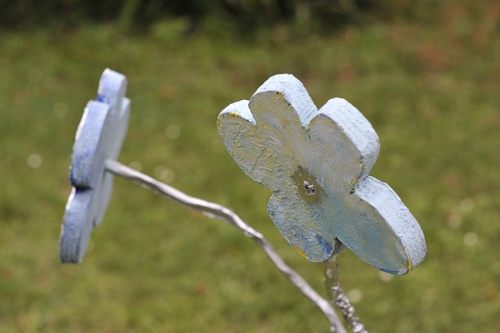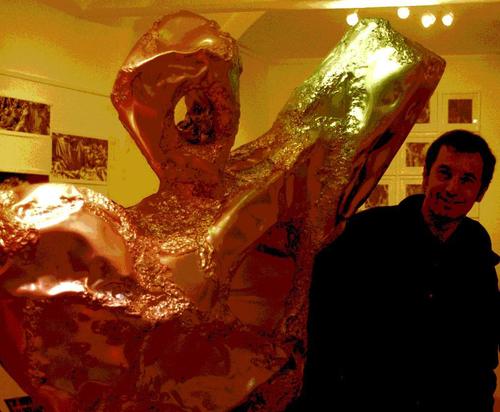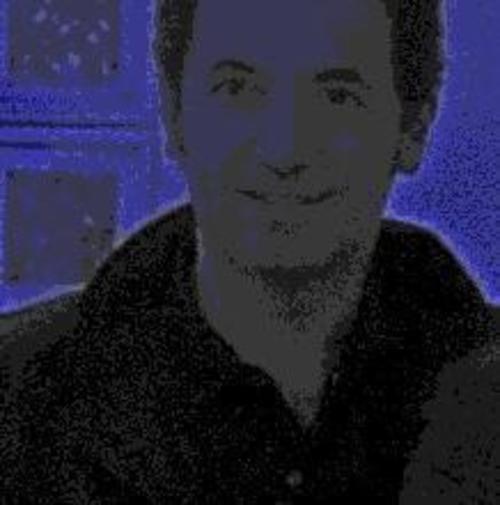During his workshops in Europe and the United States, Giacobbe Giusti became familiar with the works of the most important artists of the international art scene. This led to a desire to direct his talents toward art, and toward sculpture in particular.
His exhibition debut took place in 1995 at Kontraste Gallery in Forte dei Marmi, with a work entitled War Pictures, which is an undertaking of a style of “three-dimensional” painting that makes a strong statement and is of great social impact. Curator Giandomenico Semeraro wrote: In Giusti, the importance of landscape, grew up between the past and the immediate brutality of this, it is remarkable, and great paintings, necessarily large, grows naturally in the dense envelope material sign that is built on the support. (…) Is undoubtedly great the distance from the informal poetic, much more accountable in constructive will and in the visible consciousness of the artist's human responsibility in the current landscape, rather than not shaped by a cosmic will.
Four years later, in 1999, Elisa Chiarenza presented his works at the Palagio in Stia (Arezzo), following his participation in the collection at the Young Museum of Palazzo Ducale of Revere (Mantova), Works In Progress no.3 – Sussurri e grida (Whispers and screams); curator - Nicola Dimitri.
In 2000, at the Santa Chiara Auditorium of Sansepolcro (Arezzo), De-generi(S) naturae was presented. This term was not used so as to “make a play on the ambiguity of the meaning of the words, even though this is quite unavoidable. Rather it was used simply to try to give direction to the work… which aims not only to represent the “de-generation” of nature but also the reintroduction of its many faces or “generi” (types). - Giannì Eugenio
One must remember, in fact, that the artist alternates between painting - created with folds, drips, liquids and burns - and sculpture, in which “the impetuousness of man and his diabolic desire for eradication” is key.
In 2000 his works played an extremely important role at the events of "Agosto Corcianese", in Corciano (Perugia). Il Genio creativo tra manualità e tecnologia, (Creative genius amid handiwork and technology) written by Eugenio Giannì, marks an event of great critical and public acclaim for Giusti. The observers were charmed by the sculptures, which, situated in the spaces around the pavilion, seemed to be meteorites that had fallen unexpectedly on the splendid little city. The curator wrote: “Modulated as if by fusion, after the flash of incandescent light of atoms, divided by nuclear fission, the works of Giusti seem to topple to the ground in demonstration of a violent and unstoppable disintegration. Along the walls of these inimitable giants of art, volume and form - effectively rendered polished by the light - are displayed as inevitable destinies of an empty and torn world....The sense of fear, of unease, that the observer encounters is the obvious consequence of an interior affliction which, strangely enough, finds in nature its mirror, its soul”.
In 2001, the artist presented Axteroid Project in Radda in Chianti (Siena) and Reflex Stone at the Cantieri Culturali Ex Macelli in Prato. Axteroid Project is a “form of sculpture formulated by means of the application of astral laws” and does not represent an interruption in the trail blazed by the artists at the end of the 20th century but marks research which has yet to come to an end. Research which, on the contrary, has continually intensified, and has reached a prominent place in the artistic culture of our time.” – Giannì E.
Reflex Stone (curator - Michele Loffredo) concentrates mainly on the passage between the artist’s period of large surfaces which are wrinkled, crumpled or studded, with a consistency similar to aluminum foil, likewise brightly consumed and abandoned, and the period of large figures in which - Loffredo explains - unusual anthropomorphisms are perceived. For these the artist once again chose an irremovable dynamic energy, to the point of introducing flowers and, especially, stones and masses that, like giant dolmens and menhirs, manifest a possible metallic dimension of the existence of Mother Nature, Nature and Man, which has always come full circle in the works of Giacobbe Giusti.
The ideal confines of these two periods emerge from the magmatic acrobatics of welding. The surfaces, once shiny and bright, now glazed and polished, bear witness to the wounds of archaic fractures by way of their scars. They indicate a tireless journey that continues far beyond in search of new paths to new destinations.
Subsequently, in 2002, the artist presented Sculture art at the Teatro Montedomini in Florence, and La danza della pietra (The dance of the stone) at the Fortezza del Cassero of Castiglion Fiorentino (Arezzo). In 2003 La foresta incantata (The enchanted forest) was presented at the Stadio Comunale of Arezzo, and the exhibit Alluminio (Aluminum - curator Matteo Chini) was held at the Palazzo Casali in Cortona. Chini wrote: Giacobbe Giusti, like many artists of his generation, is not interested in a mimetic or narrative use of sculpture. He prefers to work with matter in the way that a genetic engineer transforms biological matter. In other words, more than sculpt, he prefers to mold. And so, asteroids, fragments of lava flows and conglomerates of a symbolic triangular shape are born. They stand as silent totems from space, spinning satellites hurled from outer space onto the Earth's surface.
It is the recreation of a world which contributes to the evolution of forms, following two lines which seem to be separate but are intimately linked. …This is the explanation of the presence in Giusti’s works of numerous anthropomorphic shapes that often (especially in the permanent exhibits) populate unreal “crystal forests” while maintaining their metallic and inhuman presence. These chaotic structures formed by the same Atoms of sparkling stones that surround them lose all illustrative significance and spark an emotional turbulence full of expectations. These appear as an alien presence, deceptive and enigmatic duplicates that have the exterior aspect of biological material but lack interior fragility.
In 2004 at the Sala del Caminetto of the Rocca Paolina in Perugia, the exhibit Segnali dal pianeta Terra (Signs from Planet Earth) was held.
It had the distinction of being presented as an “intrusive” setting for a “live” performance. Video projections, colored lights, scenery, brash and tempestuous sounds all permeated the setting invoking in the observer a strange inner enthusiasm and the perception of a strange and mysterious force. Drawn in by the union of the objects shaped by light and transformed by the imagination sparked by sound, the observer seems to abandon his physical self, becoming as light as a spirit in infinite space.
Curator Viviana Tessitore wrote: Giacobbe Giusti is an artist and attentive director of strange settings in which various levels of reality freely intertwine. Beings between matter and air, light and shadow, wakefulness and sleep come together in an expanded and contorted space. Working on the alliance between Earth and space, he presents scenes which appear anomalous but are capable of finding reference to and harmony with shapes that are familiar to us. Without a doubt, his theory is a futuristic one, made up of views that are constantly evolving, yet it is completely immersed in a realistic context. They are foreign forms which abide within our surroundings that, in turn, invade them. They seem to be strange signs hailing from other worlds, but the artist inverts this, and makes a necessary change: these strange manifestations do not hail from cosmic space, they are not asteroids that resulted from collisions, nor meteors or meteoric dust, much less the residue that reached the Earth’s surface. Strange as it may be, these are forms that belong to the Earth itself. Flowers, symbols, indistinguishable objects, sun, moon, light as a tiny primeval flame, matter and materials in constant movement.
The following year, in 2005, Giusti was invited by Elisa Chiarenza to the Torre Strozzi in Parlesca for the exhibit: La Torre incantata (The enchanted tower). The artist’s works, placed both outside and inside the Tower, delighted the public not only due to the intermingling of architecture, nature and works of art in aluminum, but also due to the effect that the light played on the Tower, rendering it truly “enchanted”.
Since 2006 a number of Giusti’s works are on permanent display (Textile Art) at Vignali Textiles, in Strada in Casentino (Arezzo), and in 2007, L’Altra dimensione del pianeta Terra (The other dimension of planet Earth) was presented at Edison Book Store in Piazza del Risorgimento in Arezzo. A preview for the exhibit was held, including a video presentation and a performance by three young actors: Francesca Giannini, Matteo Norci and Nicola Becattini. Giusti’s question: “Are we certain that Homo sapiens is the final evolution of the human race?” makes it difficult for the observer to find a satisfying answer, but it also sparks the hope that the artist will pose yet another of his questions to us in the future.
In 2008 Giusti was invited by Gianni Dentini to the Castle of Agello for the exhibit L’Altra dimensione. In this occasion there was the presentation by Eugenio Giannì of the monography Giacobbe Giusti- L’altra dimensione (Giacobbe Giusti- The other dimension). Wrote Giannì: A recurring theme in Giusti’s artistic research is, without a doubt, the relationship between human beings and alien creatures or Androids.
At the source of this line of thinking we find the poetics of Philip K. Dick, one the most important American science fiction authors since World War II. The dominant characteristic, particularly evident in the exhibit L’Altra dimensione del pianeta Terra (The other dimension of planet Earth) held in Arezzo in 2007, is the difficulty of certainty. If Homo Sapiens is seen as the final evolutionary stage of the human race, the next step can lead to nowhere other than his decline; a decline both existential and ethical, which will force him to survive by cooperating with or succumbing to “creatures” which he himself “made”. All of this is seen as a fantastic fabrication of our own thoughts: but how much of this is pure fantasy and how much, on the other hand, is concrete?(….) It is not only sculpture, but sounds and lights as well, that lend themselves to summoning our past and take their place as fragments in our history, creating a compilation of sorts within the work of art. The landscape becomes a composite: real and special effects meld together and render each other complete, much like the result of a temporal visit to the history within ourselves, the history from which we cannot escape since it bears witness to our reality. The entire existence is therefore the union of sounds, lights, images and words. Still frames of news broadcasts, images of planet Earth are fragments of a society that survived, a civilization linked to matter and, as a result, its only witness. The same sounds that arrive from space seem to be the signs of survivors, a call for immediate help.Therefore, the art that moves the spirit of the artist and allows him to formally put into practice the application of various astral laws - creating objects similar to astral stones, meteorites, asteroids, flowers and plants - is the fruit of an imagination which comes from within. It joins with an outside reality made up of a system in constant transformation, and of an obscure presence of mysterious forces.
Nevertheless, that which the observer feels is not a fear of these forces but an appreciation of these forms that, although derived from the energy of the universe or from their impact with the earth, still preserve some of the aesthetic dictates of our culture.
In 2009 Giusti was invited by Carla Casucci to the Public Gardens in Bibbiena for the exhibition Eco in arte and in 2010 the architect and painter Mario Nibbi presented Giusti’s work, Bagliori Artificiali , at Foiano della Chiana and Lucignano.
In 2011 the artist was invited by Fausto Forte, director of Museo Casa Masaccio, for a performance with masked actors, Artificial landscapes, in San Giovanni Valdarno. The following year, 2012, Giusti was invited by Paola Cioncolini, president of Montevarchi Arte, for the exhibition Futureland at Chiostro del Cennano in Montevarchi.
In 2012 Giusti presented in Chiostro of Cennano in Montevarchi Futureland, by Antonio Senatore and Montevarchi Arte.
In 2013 Esposizione delle opere di Giacobbe Giusti was presented in a public space at City Hall of Calenzano (Firenze) by O. Anania.


